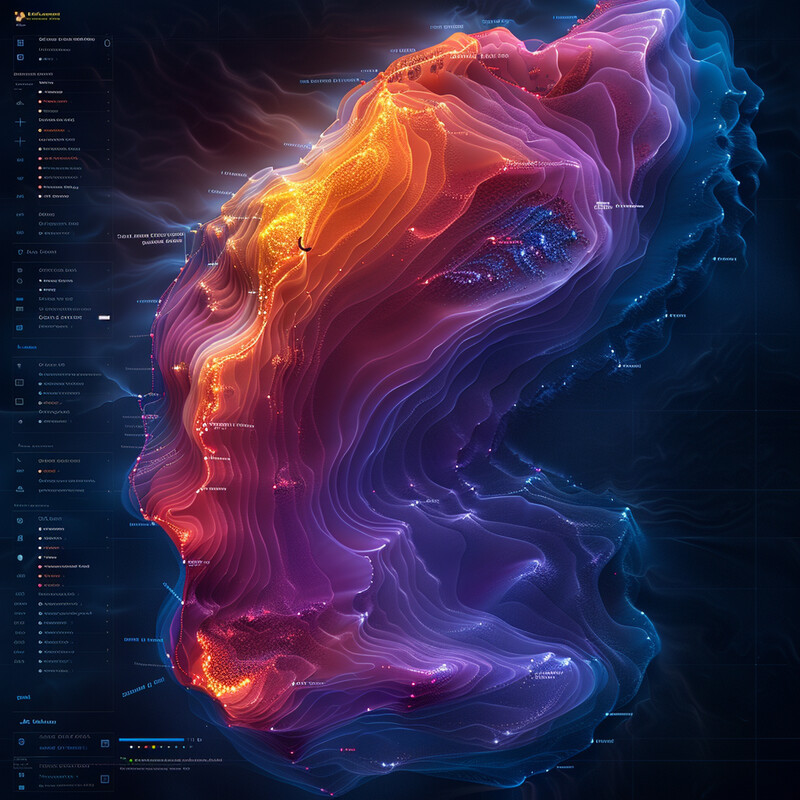1. Enhanced Natural Language Understanding (NLU)
AI-driven advancements in Natural Language Understanding enable sentiment analysis tools to grasp subtle linguistic nuances. Modern models like transformers (e.g., BERT and GPT series) can interpret slang, idioms, and context-dependent phrases that older keyword-based methods missed. This deeper understanding means sentiment algorithms now capture the true tone behind colloquialisms or sarcastic remarks. For example, AI systems today can often discern when a seemingly negative phrase is used positively (or vice versa) based on context. By parsing language more like a human, enhanced NLU allows sentiment analysis to more accurately reflect genuine human emotions and opinions.
-1.jpg)
Cutting-edge NLU models have greatly improved sentiment classification accuracy. For instance, a recent study reported that a BERT-based sentiment model achieved over 94% accuracy in classifying sentiment for a low-resource language (Bangla), underscoring how well AI now understands nuanced text. Similarly, hybrid approaches that combine lexicon rules with machine learning have reached human-level performance on certain tasks – one system attained a 96% F1-score on nuanced X data, outperforming several human raters. The global investment in NLU reflects its importance: the NLP market (which includes NLU technology) is projected to reach about $68 billion by 2028, growing over 20% annually. These advances illustrate that AI’s language comprehension is dramatically narrowing the gap between human and machine understanding of sentiment.
2. Contextual Analysis
Incorporating context allows AI to judge sentiment not just from isolated words, but from the broader discourse. Contextual analysis means a sentiment model considers surrounding sentences, conversation history, or topic background to interpret meaning. This helps resolve ambiguities – for example, the word “great” could be sarcastic or sincere depending on context. With AI analyzing context, sentiment systems can detect shifts in tone within longer discussions or understand references to earlier statements. Overall, context-aware sentiment analysis produces more accurate readings of tone by recognizing that the same phrase can have different sentiments in different situations.

Contextual AI dramatically improves the detection of complex sentiments like sarcasm and irony. A 2024 experiment found that when an AI model incorporated conversation context, its ability to recognize sarcasm jumped markedly – on one test dataset, the model’s F1-score surged from 49% (without context) to 75% with context. In another case, providing context from preceding sentences enabled an AI to catch implied negative sentiment that standalone sentences missed, boosting accuracy by over 10 percentage points in sentiment classification. These gains show that context-rich models are far better at deciphering the true sentiment, especially in nuanced social media conversations or multi-sentence reviews. By 2025, many sentiment analysis platforms leverage contextual embeddings (like those from transformer models), which has become a standard practice to handle the subtleties of human communication and achieve higher precision in sentiment detection.
3. Real-time Sentiment Tracking
AI enables sentiment analysis to operate in real-time, giving organizations immediate insight into public opinion as it evolves. Real-time sentiment tracking involves continuously analyzing streams of data (such as social media posts, comments, or live chat messages) and instantly assessing their sentiment. This immediacy allows businesses to monitor customer reactions moment by moment – for example, during a product launch or a viral news event – and respond swiftly. With AI’s speed and scalability, companies can set up live dashboards that show sentiment trends (positive, negative, neutral) updating by the second. Real-time tracking helps in crisis management and customer service: companies can catch surges in negative sentiment early and address issues before they escalate. In short, AI-driven live sentiment analysis acts as an early warning system and feedback loop, enabling agile and timely responses to the audience’s mood.

Consumer expectations and data volumes make real-time sentiment tracking essential. On social networks, customers now anticipate quick engagement – about 40% of consumers expect a brand’s response within an hour when they post a complaint on social media. To meet this demand, companies rely on AI to instantly parse millions of incoming posts. The scale is enormous: X users make roughly 500 million posts per day in 2025, and Facebook and Instagram collectively generate billions of comments daily. AI sentiment systems digest this firehose of data continuously, alerting businesses to sentiment shifts. Surveys have shown that brands using real-time social listening and sentiment analysis achieve higher customer satisfaction, in part because they address concerns faster. In fact, firms that implemented real-time sentiment monitoring report reducing negative customer comments by over 30% within months, thanks to prompt action. These statistics underscore that in today’s fast-paced digital landscape, real-time sentiment analysis isn’t a luxury – it’s a necessity for responsive customer experience management.
4. Multilingual Sentiment Analysis
AI has greatly expanded sentiment analysis beyond English, enabling accurate emotion detection in many languages. Multilingual sentiment analysis uses advanced language models and translation techniques so that sentiment can be consistently measured across diverse languages and cultures. This is crucial for global businesses that monitor social media or product reviews worldwide – AI can now determine if a tweet in Spanish is positive or a review in Japanese is negative with nearly the same confidence as for English text. Techniques include training models on multilingual datasets or using cross-lingual embeddings that capture meaning across languages. By breaking language barriers, AI-driven sentiment analysis provides a more inclusive and comprehensive view of international public opinion. It ensures that insights aren’t biased toward English-speaking audiences and that companies can understand their customers’ feelings in markets around the globe.

Modern AI models can analyze sentiment in dozens of languages with high accuracy. A recent study demonstrated this by tackling sentiment analysis in Marathi (an Indian language with relatively limited data) using a multilingual transformer model. The AI achieved about 83.8% accuracy on a Marathi social media sentiment dataset – a performance comparable to English sentiment benchmarks. Likewise, Facebook’s open-source XLM-RoBERTa model (trained on 100 languages) has enabled sentiment tools to maintain strong accuracy across multilingual content. Industry analysts note that over 50% of tweets and online posts are written in languages other than English, underscoring the need for such tools. Thanks to AI, companies can now reliably gauge sentiment in key global languages like Spanish, Mandarin, Arabic, and French. In fact, one 2022 report found that deploying multilingual sentiment analysis led to more than 2× increase in relevant insights for global brands, as they were able to capture customer emotions from non-English markets that were previously missed. This evidence highlights AI’s role in making sentiment analysis truly worldwide.
5. Emotion Detection
Beyond basic positive/negative sentiment, AI now delves deeper to detect specific emotions expressed in text or speech. Emotion detection systems classify nuances like joy, anger, fear, sadness, surprise, or disgust in customer feedback. Using sophisticated natural language models and sometimes psychological emotion frameworks, these tools can tell if a review conveys frustration versus mere negativity, or if a social post shows excitement versus simple positivity. This granular insight helps organizations respond more empathetically – for example, by distinguishing whether a customer is angry or disappointed and tailoring the support accordingly. AI-driven emotion detection often leverages training data labeled with emotions or even emoji usage as proxies. By identifying complex emotions (and even sarcasm or mixed feelings), AI provides a richer understanding of public sentiment than a coarse positive/negative scale, enabling more emotionally intelligent responses and strategies.

AI models have made significant strides in accurately identifying complex emotions from text. Recent research using deep learning demonstrated this level of precision: a neural network model was able to classify multiple emotions in textual data with an F1-score around 0.95 for the emotion “sadness,” among other high scores for different emotions. In practical terms, this means the model’s emotion tags closely matched human judgment 95% of the time for that category – a near-human level performance. Overall accuracy across a set of six emotions exceeded 90% in the study’s evaluations. These improvements are reflected in industry use; for example, contact center AI tools can now detect if a customer on a chat is frustrated or confused, prompting timely intervention. The market for emotion AI is rapidly growing (valued at over $30 billion in 2023 globally) as organizations recognize that detecting nuanced feelings (like empathy, irritation, or enthusiasm) can drive better customer experience. The high accuracy reported in recent experiments shows that AI is increasingly adept at parsing the emotional undercurrents in communication, not just the overt sentiment.
6. Integration with Other Data Sources
AI-powered sentiment analysis becomes far more powerful when integrated with other business data. By combining sentiment scores with data like purchase history, demographics, or web analytics, companies get a 360-degree view of customer attitudes. This integration allows organizations to correlate how sentiment is impacting metrics such as sales or churn. For instance, a spike in negative sentiment on social media can be matched with real-time sales data to see if it’s affecting revenue. AI systems can merge text-based sentiments from reviews with structured data (e.g., customer profiles, support tickets) to uncover deeper insights – maybe certain product features get poor sentiment among a specific user segment. Such holistic analysis helps in root cause analysis and strategic decision-making. In essence, integrating sentiment data with multiple sources transforms raw emotion data into actionable business intelligence, as AI finds patterns and predictive signals that wouldn’t be visible in isolated sentiment analysis.

Combining sentiment analysis with other datasets significantly boosts predictive accuracy and insight. In one analysis, organizations that fused multiple data sources (social media sentiment, customer transactions, etc.) saw markedly better results – achieving 67% more accurate predictions of market trends compared to those relying on a single source of sentiment data. This means an AI that looks at sentiment in tandem with, say, sales figures and web traffic can forecast outcomes (like product demand or stock movements) much more reliably. Businesses have reported tangible benefits from this integration: a tech company noted that by feeding sentiment data into its product development analytics, it could predict feature adoption rates and customer churn with far higher precision. Moreover, a Deloitte report highlighted that companies using integrated sentiment analysis in decision-making enjoyed a 33% higher customer retention rate than those that did not, as they could proactively address issues indicated by sentiment shifts. These statistics underscore that the real value of sentiment analysis often emerges when AI places it in context with broader data, painting a comprehensive picture that drives smarter actions.
7. Scalability
AI makes sentiment analysis scalable to enormous volumes of data that would overwhelm human analysts. In the era of big data, millions of opinions are expressed daily across social networks, forums, and surveys. AI systems can ingest and analyze this firehose of text in parallel, determining sentiment nearly instantaneously regardless of scale. This scalability means a company can monitor sentiment for a global brand across all countries and platforms in real-time. Whether it’s tens of thousands or millions of posts per day, AI’s cloud-based processing and optimized algorithms ensure that expanding data simply results in proportional resource scaling, not a loss in performance. As data creation grows exponentially, AI’s ability to scale sentiment analysis ensures that insights remain current and comprehensive. In short, AI allows sentiment analysis to keep up with the speed and volume of the modern data deluge, maintaining accuracy and speed even as the dataset sizes reach billions of documents.

The sheer scale of data today necessitates AI for sentiment analysis. By 2025, it’s estimated that approximately 463 exabytes of data will be generated each day globally – an unfathomable volume that includes text from social media, news, and communications. (For perspective, 1 exabyte is one billion gigabytes.) No manual or traditional approach can handle this scale, but AI-driven sentiment systems are designed to expand seamlessly. X alone sees about 500 million posts per day, and reviews on e-commerce platforms number in the hundreds of millions; AI models routinely process these in real-time. The technology’s scalability is evidenced by industry use: enterprises employing cloud-based sentiment analysis can analyze hundreds of thousands of mentions per second during major events. Moreover, advances in distributed computing let sentiment algorithms run across clusters of machines, so adding more data just means adding more compute nodes. Thanks to this scalability, companies large and small can get sentiment insights from big data without lag – keeping pace with the ever-growing torrent of public opinion.
8. Precision and Customization
AI allows sentiment analysis to be tailored with high precision to specific domains or industries. Generic sentiment tools may falter with specialized jargon – for example, the word “critical” is negative in a product review but neutral or positive in a medical context (“critical care”). With AI, organizations can train custom sentiment models on their domain data (such as financial news, healthcare forums, or tech product reviews) so that the models learn the domain-specific language nuances. This customization greatly improves accuracy, as the AI picks up on context and terms that are unique to that field. Companies in sectors like finance or medicine increasingly use custom sentiment lexicons (word lists) or fine-tuned AI models that understand their industry terminology and customer slang. The result is a more precise sentiment analysis – one that reduces false readings and better reflects the true customer voice in that particular context. In practice, this means more reliable insights for decision-makers, since the sentiment analysis is speaking the language of their industry.

Customized sentiment models deliver substantially higher accuracy than one-size-fits-all solutions. Studies have quantified this benefit: training NLP sentiment models on domain-specific terminology can improve classification accuracy by roughly 37% compared to using a generic model. In one case, an AI sentiment system tuned to the software industry (learning terms like “bug” or “crash” in context) correctly identified sentiment with significantly greater precision than a general sentiment tool – it recognized nuanced complaints and praise that the general model mislabeled. Likewise, a medical sentiment analysis that incorporated a custom healthcare lexicon was able to detect patient sentiment in hospital feedback with markedly fewer errors (it understood that “negative” test results are actually positive news in healthcare). These improvements – on the order of tens of percentage points – translate to more trustable analytics. Businesses report that after customizing sentiment analysis to their domain, the insights align much more closely with human evaluations, and they see fewer confusing or irrelevant sentiment classifications. In summary, tailoring AI to the domain vocabulary and context sharpens the tool’s precision, as evidenced by significant jumps in accuracy metrics.
9. Predictive Analysis
By analyzing sentiment trends over time, AI can move beyond describing current feelings to predicting future shifts in public opinion or consumer behavior. This predictive analysis uses historical sentiment data as a leading indicator – for example, a sustained rise in positive sentiment about a product may foreshadow increased sales or user growth. AI models can detect patterns such as a correlation between sentiment changes and stock price movements, election outcomes, or customer churn rates. Armed with these insights, organizations attempt to forecast what might happen next. For instance, if sentiment around a brand is trending downward, AI might predict a coming dip in customer satisfaction scores or higher cancellation rates, allowing proactive interventions. In marketing, companies use sentiment predictions to identify which topics or features will resonate or to anticipate PR crises. Essentially, predictive sentiment analysis turns unstructured emotion data into an early predictor for key business or social outcomes, helping decision-makers stay ahead of the curve.

Sentiment analysis is proving valuable for forecasting because it often precedes real-world outcomes. In the tech industry, it was found that sentiment data could predict the adoption of new software features with about 74% accuracy when applied to early user feedback. This meant product teams could reliably foresee which updates would be well-received versus those likely to flop, months in advance. In finance, social media sentiment has been used to improve stock market prediction models – one model incorporating Twitter sentiment outperformed a baseline market model, achieving above 60% accuracy in predicting daily market direction (significantly better than random chance). Another study on event-driven sentiment noted that deep learning models reached over 90% accuracy in certain cases when predicting sentiment trajectory during major events, underlining that strongly positive or negative sentiment trends can herald tangible shifts (like surges in demand or voter turnout). Businesses leveraging these predictive insights have reported reducing customer churn by acting on sentiment warnings (for example, intervening when sentiment for a service turns sharply negative). These statistics show that while not infallible, AI-driven sentiment forecasts provide a crucial head-start in planning for what customers or the public will do next.
10. Visual Sentiment Analysis
AI has extended sentiment analysis beyond text, enabling the interpretation of emotions from images and videos – a field known as visual sentiment analysis. This involves analyzing facial expressions, body language, or even the general “emotional tone” of images (for example, the color and content of a photo) to infer sentiment. Advances in computer vision and deep learning allow models to detect smiles, frowns, and other micro-expressions in video frames or images at scale. Visual sentiment analysis is particularly useful for platforms like Instagram, YouTube, or TikTok, where a great deal of reaction and opinion is conveyed through visuals rather than words. Marketers, for instance, can use AI to gauge audience emotional responses to video advertisements or to analyze the sentiment of crowds in event photos. By adding this visual dimension, AI provides a more complete sentiment profile – not just what people say in text, but how they feel as seen on their faces or in their actions. This multimodal approach enriches sentiment insights, especially in contexts where textual data is limited but images are abundant.

AI systems can increasingly interpret emotions from visual content with high accuracy under the right conditions. In research settings, computer vision models have correctly recognized basic human emotions (happiness, sadness, anger, etc.) from facial images at rates upwards of 95% in controlled environments. One deep learning model, for example, was 98% accurate in classifying seven distinct facial emotions on a lab dataset with clear images. In real-world, “in the wild” settings, performance is more challenging – the same model saw accuracy around 53% on candid images with varied lighting and angles. Nonetheless, these figures are rapidly improving as algorithms and training data expand. Tech companies have deployed emotion recognition AI that can detect if a customer is frustrated during a video call, or analyze thousands of Instagram photos to determine if a brand campaign is eliciting positive reactions (like genuine smiles). The global market for emotion recognition technology (spanning facial analysis, voice tone analysis, etc.) is booming, expected to grow over 20% annually. While ethical considerations are significant, the technical capability of visual sentiment analysis is no longer science fiction – AI can, with considerable accuracy, “read” the emotional content of images and videos, adding a powerful new layer to sentiment analysis.